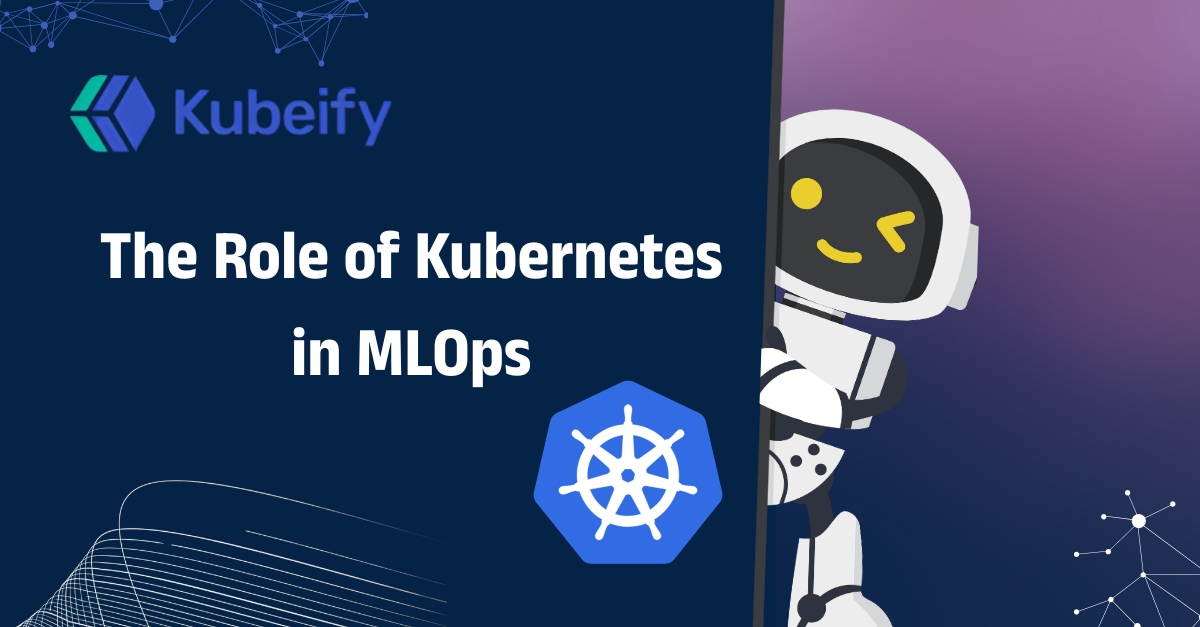AI Cloud
- Cloud Native Product Development
- Cloud Native FaaS
- Monolith to Microservices
- DevSecOps as a Service
- Kubernetes Zero Downtime

Machine learning (ML) has moved beyond research labs into mainstream business applications—powering recommendation engines, fraud detection, personalized healthcare, and much more.
Introduction
What is MLOps and Why It Matters
Kubernetes: A Foundation for Modern ML Infrastructure
Why Kubernetes and MLOps Work Well Together
Key Benefits of Using Kubernetes in MLOps
Core Kubernetes Features for MLOps Pipelines
Containerization
Scaling & Resource Management
Storage & Data Management
Networking & Service Discovery
CI/CD and GitOps Integration
Data Ingestion & Preparation
Feature Engineering
Model Training at Scale
Model Packaging & Deployment
Monitoring & Drift Detection
Kubernetes Ecosystem Tools for MLOps
Real-World Use Cases of Kubernetes in MLOps
Challenges of Running MLOps on Kubernetes
Best Practices for Kubernetes in MLOps
Future of Kubernetes in MLOps
Conclusion
FAQs
Machine learning (ML) has moved beyond research labs into mainstream business applications—powering recommendation engines, fraud detection, personalized healthcare, and much more. However, getting ML models from notebooks into production environments at scale remains a significant challenge.
This is where MLOps (Machine Learning Operations) comes into play. By blending DevOps principles with machine learning workflows, MLOps helps organizations automate, deploy, and manage ML models efficiently. But to make MLOps truly scalable and reliable, you need a strong infrastructure foundation.
Enter Kubernetes—the de facto standard for container orchestration. Kubernetes enables scalable, portable, and automated infrastructure management, making it an ideal backbone for production-grade MLOps pipelines.
MLOps is the practice of streamlining the machine learning lifecycle—from data preparation and training to deployment and monitoring—through automation and collaboration.
Traditional ML workflows often suffer from:
Manual handoffs between data scientists and engineers.
Difficulty reproducing experiments.
Scalability issues when datasets or models grow.
Lack of monitoring and version control in production.
MLOps addresses these challenges by introducing:
Automation of model training, deployment, and retraining.
Collaboration across data, ML, and engineering teams.
Monitoring for drift, bias, and performance.
Scalability to handle enterprise-grade workloads.
Kubernetes is an open-source container orchestration platform originally developed by Google. It automates the deployment, scaling, and management of containerized applications.
For machine learning workloads, Kubernetes provides:
A scalable infrastructure for distributed training.
Standardization across environments (development, staging, production).
Flexibility to run on any cloud or on-premises.
Automation for deployments, rollouts, and resource management.
This makes Kubernetes the perfect match for implementing MLOps at scale.
MLOps requires infrastructure that can handle:
Complex pipelines with multiple stages (data, training, serving).
Elastic scaling for workloads (GPU/TPU for training, CPU for inference).
Reproducibility across teams and environments.
High availability for mission-critical ML applications.
Kubernetes naturally provides these capabilities. By managing containers, Kubernetes ensures ML workflows are scalable, portable, and reproducible—key requirements for MLOps success.
Scalability: Scale model training and inference horizontally.
Portability: Run the same pipeline across cloud and on-premise.
Resource Efficiency: Allocate CPUs, GPUs, and memory dynamically.
Automation: Automate deployments, updates, and rollbacks.
Monitoring & Logging: Native integrations with Prometheus and Grafana.
Flexibility: Support for hybrid and multi-cloud ML workloads.
Encapsulates ML dependencies and environments.
Ensures reproducibility across development and production.
Horizontal Pod Autoscaler scales models on demand.
GPU/TPU scheduling for heavy training jobs.
Persistent Volumes (PV) and Persistent Volume Claims (PVC).
Integration with data lakes (S3, GCS, HDFS).
Kubernetes services expose ML models as APIs.
Ingress controllers manage secure external access.
Integrates with Jenkins, ArgoCD, and GitLab CI.
Enables continuous training (CT) and continuous deployment.
Use Apache Kafka or Spark on Kubernetes for streaming data.
Store datasets in distributed storage connected via Kubernetes PVs.
Automate with Kubeflow Pipelines or Airflow.
Store reusable features in a feature store (Feast, Tecton).
Train models on GPU-enabled Kubernetes clusters.
Use Kubeflow Training Operators for TensorFlow, PyTorch, or XGBoost.
Package models with Docker & BentoML.
Deploy with KFServing or Seldon Core.
Use Evidently AI for drift detection.
Monitor performance with Prometheus + Grafana dashboards.
Kubeflow – End-to-end ML orchestration.
KFServing / KServe – Model serving at scale.
Seldon Core – Advanced model deployment and monitoring.
Argo Workflows – Workflow automation for pipelines.
MLflow – Experiment tracking and model registry.
Evidently AI – Drift detection and monitoring.
Healthcare: Deploying ML models for diagnostic imaging at scale.
E-commerce: Real-time recommendation engines.
Finance: Fraud detection systems with low-latency inference.
Telecom: Customer churn prediction pipelines.
Autonomous Vehicles: Training and deploying computer vision models.
Complexity: Steep learning curve for teams new to Kubernetes.
Cost: GPU scaling can become expensive without optimization.
Data Gravity: Moving large datasets into Kubernetes clusters is non-trivial.
Security & Compliance: Requires strong governance for sensitive ML workloads.
Use Infrastructure-as-Code (IaC) with Helm or Terraform.
Adopt GitOps workflows for pipeline automation.
Monitor resource utilization to control costs.
Use namespaces and RBAC for security.
Continuously retrain models with automated triggers.
LLMOps: Running large language models (LLMs) at scale on Kubernetes.
Edge MLOps: Deploying ML models on Kubernetes at the edge for IoT.
Serverless ML: Kubernetes-based FaaS for ML inference.
AutoMLOps: Self-healing, auto-optimizing ML pipelines on Kubernetes.
Kubernetes has emerged as the backbone of modern MLOps, enabling scalable, portable, and automated machine learning workflows. By combining containerization, orchestration, and automation, Kubernetes empowers organizations to move beyond experimentation and deliver real-world ML applications at scale.
From training massive models to deploying real-time inference APIs, Kubernetes provides the flexibility and reliability required for production-grade MLOps. As ML adoption grows, Kubernetes will continue to play a critical role in shaping the future of AI infrastructure.
Q1. Why is Kubernetes important for MLOps?
Kubernetes provides scalable infrastructure for automating ML pipelines, making deployment and management more efficient.
Q2. Can Kubernetes handle GPU workloads for ML?
Yes, Kubernetes natively supports GPU scheduling for ML training and inference.
Q3. What are the best tools for MLOps on Kubernetes?
Kubeflow, KFServing, Seldon Core, Argo Workflows, and MLflow are commonly used.
Q4. How does Kubernetes improve scalability in ML pipelines?
By enabling horizontal scaling of model training and serving workloads.
Q5. Is Kubernetes mandatory for MLOps?
Not mandatory, but highly recommended for enterprises needing scalable, reproducible pipelines.
Q6. How does Kubernetes support continuous training (CT)?
By integrating with CI/CD tools and automating retraining pipelines.
Q7. Can Kubernetes be used for real-time ML inference?
Yes, using services like KFServing or Seldon Core.
Q8. What challenges exist when using Kubernetes for MLOps?
Complexity, cost management, data integration, and security compliance.
Q9. How does Kubernetes ensure reproducibility in ML workflows?
By packaging ML environments into containers that run consistently across environments.
Q10. What’s the future of Kubernetes in MLOps?
The future includes LLMOps, edge deployments, and serverless ML powered by Kubernetes.

Kubeify's team decrease the time it takes to adopt open source technology while enabling consistent application environments across deployments... letting our developers focus on application code while improving speed and quality of our releases.
– Yaron Oren, Founder Maverick.ai (acquired by OutboundWorks)
Let us know what you are working on?
We would help you to build a
fault tolerant, secure and scalable system over kubernetes.
